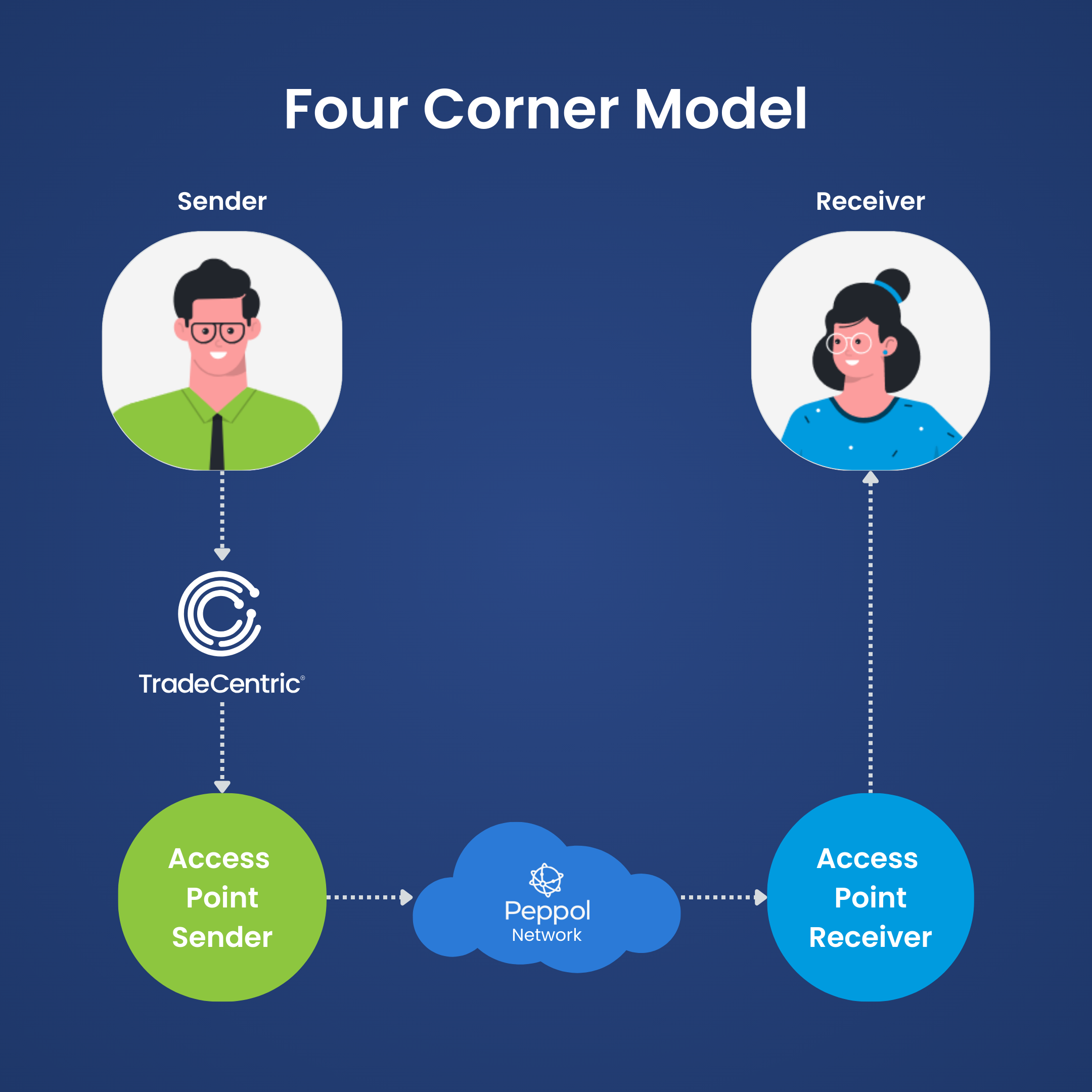Table of Contents
Electronic invoicing is one of the essential building blocks for B2B Connected Commerce, the capability that connects buyer and supplier systems to deliver a seamless, efficient and flexible end-to-end procurement process.
With Connected Commerce, a buyer selects products directly from the supplier using PunchOut catalogs. This then generates and authorizes an electronic Purchase Order (PO) that is issued directly into supplier systems. Finally, the supplier system receives and processes an electronic invoice, all within the same digital process flow.
Electronic invoicing delivers faster, more efficient invoicing as part of this integrated flow, removing the need for manual invoice matching and other processes that add time and cost.
With the rise in B2B eCommerce connections and transactions, common standards and a shared network for electronic invoices is critical to invoicing security and efficiency. This is where the Peppol network plays a key role.
What is Peppol?
Peppol (Pan-European Public Procurement Online) is a standardized framework that enables the secure, efficient exchange of electronic business documents, such as invoices and purchase orders, across different business systems and government agencies.
Developed in Europe and now adopted globally, Peppol provides a set of technical standards and a secure network for B2B and B2G (business-to-government) transactions, which helps organizations achieve streamlined, cross-border electronic invoicing and other digital commerce activities. Peppol service providers facilitate access to this network via a Peppol access point, enabling businesses to connect seamlessly and securely with partners worldwide.
How the Peppol Network Works
PPeppol replaces individual national standards for exchanging electronic documents, such as e-invoices or purchase orders, with a single, secure, standardized framework. This approach eliminates the complexity of building and maintaining multiple custom integrations, making it easier for organizations to connect and transact globally.
The Peppol network is supported by more than 300 certified Access Points worldwide. These Access Points act as trusted gateways for sending and receiving e-invoices, purchase orders, and other business documents. By connecting once to an Access Point, a business can exchange documents with any other organization on the Peppol network—no matter their location, industry, or internal systems.
Peppol in three steps
- Connect: A business subscribes to a certified Peppol Access Point through a service provider.
- Send: Your Access Point formats and securely routes your invoices or documents to the recipient’s Access Point.
- Receive: Your Access Point delivers incoming e-invoices and documents from other organizations on the Peppol network directly into your internal systems.
What is a Peppol Access Point?
A Peppol Access Point is your secure entryway to the Peppol network. Rather than setting up direct, one-off connections with each trading partner, you connect to a single certified service provider.
Once connected, your Access Point:
- Formats your documents according to Peppol specifications
- Transmits them securely to your recipient’s Access Point
- Receives incoming documents from other Access Points and delivers them into your internal systems
This model not only saves time and resources but also ensures compliance with Peppol’s strict interoperability and security standards.

Four Corner Model
Peppol transactions follow a “Four Corner Model,” which creates a standardized, secure way to exchange documents:
- Sender: The organization sending the document.
- Sender’s Access Point: Routes and formats the document according to Peppol specifications.
- Recipient’s Access Point: Receives and validates the document.
- Recipient: The organization receiving the document.
This structure eliminates the need for direct point-to-point connections, making it easier to scale your e-invoicing capabilities across multiple trading partners.
The Four Pillars of Peppol
Peppol is built on four key pillars that ensure reliability and trust in every transaction:
- Standardized Formats: Common document types and data structures for consistent communication.
- Secure Transport: Encryption and authentication to protect sensitive business information.
- Legal Framework: Shared rules and agreements for compliant cross-border transactions.
- Governance Model: Oversight and certification to maintain network integrity.
Together, these pillars create a predictable, secure environment for exchanging business documents across industries and geographies.
Ready to Streamline Your Peppol e-Invoicing?
5 Key Benefits of the Peppol Network
The automated capabilities of the Peppol network significantly reduce the need for manual data entry and help minimize errors. Key benefits of Peppol include:
- Global Reach: The Peppol network supports seamless cross-border transactions, allowing businesses to overcome local variations in invoicing standards and engage with partners across different countries. This global accessibility promotes smoother international trade and collaboration.
- Improved Efficiency: By automating invoice processing, Peppol accelerates the entire invoicing workflow. This reduces reliance on manual entry, speeding up transactions and freeing up valuable time for employees to focus on more strategic tasks.
- Enhanced Security: Peppol’s standardized protocols offer robust protection for data exchanged across the network. This ensures that sensitive information such as financial details is securely transmitted between businesses, reducing the risk of data breaches or unauthorized access.
- Cost Savings: The network helps companies reduce reliance on paper-based processes, which leads to significant cost savings in terms of materials, storage, and administrative labor. By optimizing resources, Peppol contributes to a leaner, more sustainable approach to transaction management.
- Compliance: Peppol enables businesses to meet varying international invoicing regulations, which minimizes compliance risks. By standardizing invoicing processes, Peppol keeps businesses in line with regulatory requirements, avoiding penalties or operational delays associated with non-compliance.
The Importance of Peppol in B2B Transactions
Today’s B2B digital commerce is all about removing barriers to smooth, seamless interactions between businesses, across national borders and technologies.
Peppol plays a critical role in breaking down barriers by:
- Growing Adoption: Peppol is increasingly accepted by governments and corporations worldwide, opening new opportunities for those businesses that adopt it.
- Future-Proofing Business Operations: This growth in Peppol adoption will help businesses stay competitive in global markets by facilitating international trade.
- Regulatory Push: Many regions mandate or encourage Peppol for compliance, so businesses that use it will spend less time and effort dealing with individual regional compliance requirements.
From Peppol Connection to Full Integration with TradeCentric
Connecting to a Peppol Access Point is only one part of the equation. While Peppol enables standardized, secure document exchange, it doesn’t automatically integrate with your internal systems or workflows. Without the right integration strategy, organizations can still face delays, data mismatches, and compliance gaps.
That’s where TradeCentric comes in. We extend the value of Peppol by delivering:
- Seamless ERP and eProcurement Integration: Connect Peppol directly to your existing platforms without disrupting approval workflows or master data.
- Multi-Document Support: Go beyond e-invoices to include purchase orders, order confirmations, credit notes, and advanced shipping notices.
- Automated Data Mapping & Validation: Ensure every document meets Peppol specifications while aligning with your business rules.
- Scalable Trading Partner Enablement: Onboard new suppliers and buyers across multiple regions from a single connection.
- End-to-End Compliance: Meet regional mandates today and adapt quickly as new regulations emerge.
With TradeCentric, Peppol becomes a strategic advantage, not just a compliance checkbox.
TradeCentric’s Support for Peppol Global Invoicing
TradeCentric now includes a Certified Peppol access point to support invoicing between organizations in EMEA and other regions globally. TradeCentric offers secure, end-to-end integration solutions designed to simplify the entire invoice processing lifecycle between suppliers and their trading partners. By streamlining this process, TradeCentric enables suppliers to manage transactions more efficiently, reducing complexity and ensuring accurate, timely exchanges of critical business documents.
With TradeCentric’s support for Peppol, suppliers can seamlessly handle essential transactions, including invoices, within a single, cohesive platform. This comprehensive support ensures that suppliers can meet trading partner requirements effortlessly, enhancing operational efficiency and fostering stronger, more reliable business relationships.
Ready to transact on the Peppol network and streamline your global invoicing? Contact us today to get started.
Peppol FAQs
Peppol stands for Pan-European Public Procurement Online. Originally launched by the European Commission to streamline cross-border public procurement, Peppol has since evolved into a global network for standardized, secure electronic document exchange—supporting both public and private sector transactions.
Peppol is an international framework and network that enables the secure exchange of standardized electronic business documents, such as e-invoices and purchase orders, between trading partners. Instead of building individual integrations with each customer or supplier, organizations connect to a certified Peppol Access Point. Once connected, they can transact with any other participant on the network—regardless of geography, internal systems, or industry-specific formats—while meeting relevant compliance requirements.
Peppol is used by both buyers and suppliers across public and private sectors. In government procurement, Peppol supports transparency and compliance in cross-border trade. In the private sector, it enables enterprises to scale e-invoicing, purchase order automation, and other document exchanges efficiently.
Industries actively using Peppol include:
- Manufacturing and industrial supply chains
- IT products and services
- Retail and wholesale distribution
- Healthcare and life sciences
- Food and beverage
- Education and public institutions
Countries with significant Peppol adoption include:
- The United States and Canada (in targeted industries and pilot programs)
- Most EU member states
- Australia and New Zealand
- Singapore and Japan
- Select markets in the Middle East
Peppol mandates vary by country and often apply to business-to-government (B2G) transactions, with some regions extending requirements to business-to-business (B2B) invoicing.
- Europe: Many EU countries, including Italy, France, and Germany, require Peppol for certain public sector procurement processes.
- Australia and New Zealand: Peppol is the preferred standard for e-invoicing in both public and private sectors.
- Singapore: Mandates Peppol for e-invoicing in government procurement and promotes adoption in the private sector.
- Other Regions: Adoption is expanding through regional initiatives and trade agreements, with mandates emerging in Asia-Pacific, the Middle East, and North America.
Even in non-mandatory regions, many enterprises adopt Peppol voluntarily to streamline supplier onboarding, reduce compliance risks, and enable efficient cross-border trade.
Being Peppol compliant means your documents meet Peppol’s technical standards, legal framework, and security requirements, and are exchanged through a certified Access Point. With TradeCentric, compliance is built into a fully managed integration that connects Peppol directly to your existing systems for seamless, cross-border transactions.
Yes, Peppol can handle more than just invoices. While e-invoicing is the most common use case, Peppol supports multiple business document types—including purchase orders, order confirmations, dispatch advice (advanced shipping notices), and credit notes—making it a scalable solution for end-to-end document exchange.
Yes, Peppol can integrate with complex ERP and eProcurement systems. Peppol Access Points can be configured to map standardized document formats directly into your ERP or eProcurement environment without altering internal approval chains or data structures. TradeCentric specializes in ensuring this integration is seamless, preserving your current workflows while extending connectivity across all Peppol participants.




